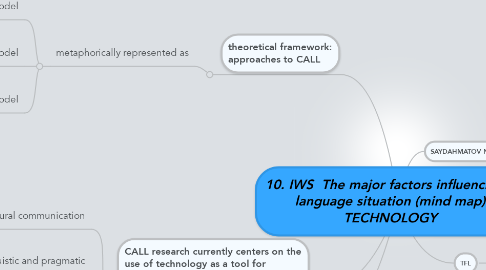
1. theoretical framework: approaches to CALL
1.1. metaphorically represented as
1.1.1. 1: computer-as-tutor model
1.1.1.1. grounded in the structuralist approach to FL. Language: conctrete, memorized to approximate, a prescriptive norm. model sentences provided. learners accuracy stressed.
1.1.2. 2. computer-as-pupil model
1.1.2.1. the computer provides tools and resources but it is up to the learner to do something with these in a simulated environment. this model distances the teacher from the students. collaborative nature of learning is lost.
1.1.3. 3. computer-as-tool model
1.1.3.1. emphasizes computer use to enhance language teaching within the context of collaborative classroom. Students have more chances to communicate with others. computer: tool to facilitate human interaction.
2. CALL research currently centers on the use of technology as a tool for communication:
2.1. intercultural communication
2.1.1. web 2.0 technologies expands the potential for interactive participation through social networking, tagging,etc. it brings about great implications for the co-construction of knowledge.
2.2. sociolinguistic and pragmatic development
2.2.1. using tachnology-mediated communication fosters great awaressnes of sociolinguistic and socioptragmatic features of discourse. learners' access real data help them become aware of the different registers and varieties of language in either formal or informal way
2.3. online communication and linguistic accuracy
2.3.1. CMC is usefull for promoting linguistic accuracy through a focus-on-form approach. peer feedback is enhanced: e-tutoring and e-partnering
